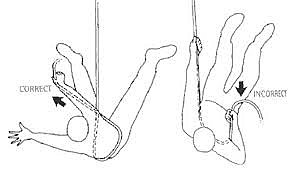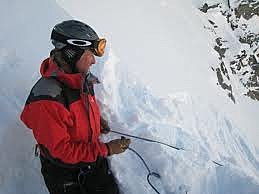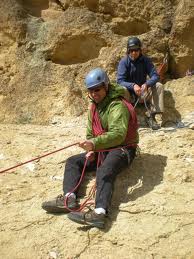 Besides locating firm footing, a rescuer on a throw rope still needs to handle pretty significant loads while bringing the swimmer on the end of the line to shore. Pulling with just your arms is often a losing battle, you need to use much larger muscles like your legs. Mountaineers and climbers use various belay techniques to transfers the load to their legs and use their body weight as well. When setting up a belay, always think about how you can quickly escape if necessary. A belay on the end of a rope whether standing or sitting runs the rope behind you just below the top of your hips. To escape, simply drop the rope. Unlike climbers we really don't have a belay device - we are using our body as the friction/belay device. We still need to follow the same rules though, never let go of the brake hand. The brake hand for us is the non-load bearing end of the rope (the one without the swimmer). We "brake" by bringing the brake end of rope in front of us and between our legs (maximizes friction). When you are in the brake position, you can slide your brake hand closer to your body to take up the slack.
Besides locating firm footing, a rescuer on a throw rope still needs to handle pretty significant loads while bringing the swimmer on the end of the line to shore. Pulling with just your arms is often a losing battle, you need to use much larger muscles like your legs. Mountaineers and climbers use various belay techniques to transfers the load to their legs and use their body weight as well. When setting up a belay, always think about how you can quickly escape if necessary. A belay on the end of a rope whether standing or sitting runs the rope behind you just below the top of your hips. To escape, simply drop the rope. Unlike climbers we really don't have a belay device - we are using our body as the friction/belay device. We still need to follow the same rules though, never let go of the brake hand. The brake hand for us is the non-load bearing end of the rope (the one without the swimmer). We "brake" by bringing the brake end of rope in front of us and between our legs (maximizes friction). When you are in the brake position, you can slide your brake hand closer to your body to take up the slack.
 Belay Types
Belay Types
Standing Hip Belay Example of a standing hip belay, rope should cross the top of your butt.
 Sitting Hip Belay Example of a sitting hip belay. The person behind him provides additional and safe anchoring support. You can use a tree as an anchor instead if you are wearing a rescue vest (quick release buckle). Here is a video of this technique: Belay using a tree anchor.
Sitting Hip Belay Example of a sitting hip belay. The person behind him provides additional and safe anchoring support. You can use a tree as an anchor instead if you are wearing a rescue vest (quick release buckle). Here is a video of this technique: Belay using a tree anchor.
You can assist a belayer by pressing down on their shoulders or pulling down on their PFD. Try not to pull back on them which can cause the feet to slide outwards. Think of it as hammering a nail into wood - perpendicular works best. This technique is called the Buddy Belay.
In a dynamic belay, instead of holding the line in a fixed position you can gradually pay out line or move down the shoreline. This reduces the shock load, sometimes helpful and in some cases enables you to land the swimmer in a safer landing zone. Just be careful with your footing when applying this technique.
If you need to belay from the middle of a line, don't wrap the line around your body. Once again, think fast escape. Bend the rope and use the bend for your brake hand. If you need a quick escape, drop the bent line. This technique is known as a belay on a bight.
You can also use a tree or boulder to handle the load instead of your back - sweet! Simply bend the rope around the immovable object and let friction handle the load. Your body's weight becomes the braking system.
Line on downstream side
One other belaying tip, always place the load bearing line on the downstream side of your body. This method makes braking easier and enables a much faster escape when dropping the line under load.
